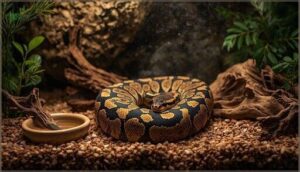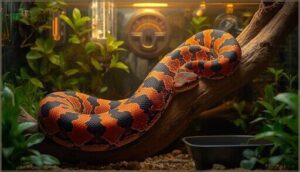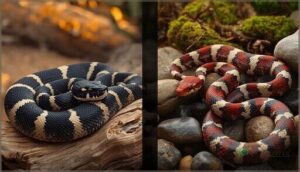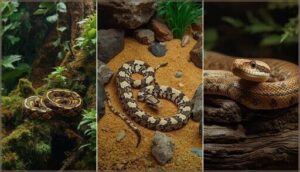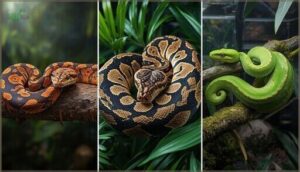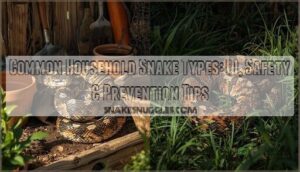This site is supported by our readers. We may earn a commission, at no cost to you, if you purchase through links.
 Your first snake doesn’t have to be a gamble. While some species tolerate handling mistakes and thrive in basic setups, others need precise temperature zones, specific humidity levels, and years of keeper experience to stay healthy. The difference between a corn snake and a reticulated python isn’t just size—it’s the gap between a forgiving companion and a challenge that can overwhelm even dedicated owners.
Your first snake doesn’t have to be a gamble. While some species tolerate handling mistakes and thrive in basic setups, others need precise temperature zones, specific humidity levels, and years of keeper experience to stay healthy. The difference between a corn snake and a reticulated python isn’t just size—it’s the gap between a forgiving companion and a challenge that can overwhelm even dedicated owners.
Picking the wrong species leads to stress for both you and the animal, but understanding different snake breeds and their care requirements changes everything. Each species brings distinct needs for housing, feeding, and health management that directly shape your daily routine and long-term commitment.
Table Of Contents
Key Takeaways
- Beginner-friendly species like ball pythons and corn snakes tolerate handling mistakes and thrive in basic setups, while advanced species like reticulated pythons and green tree pythons demand precise temperature zones, specialized humidity control, and years of keeper experience to prevent serious health issues.
- Your snake’s enclosure requirements directly determine its health—proper temperature gradients (88-92°F warm zones), humidity levels (40-80% depending on species), secure hides in both zones, and appropriate substrate prevent up to 80% of common problems like respiratory infections and incomplete sheds.
- Feeding schedules and prey sizing must match your snake’s species and age—juveniles eat every 5-7 days while adults need meals every 1-4 weeks, and incorrect prey sizing (exceeding 1.5 times body width) ranks among the top causes of regurgitation and feeding injuries.
- Regular veterinary care from exotic specialists costs $40-80 for routine visits but prevents $800 emergencies, while quarantining new snakes for 90+ days and maintaining weekly enclosure cleaning reduces disease transmission by 80%.
Popular Pet Snake Breeds
Choosing the right snake starts with understanding which species match your experience level and lifestyle. Some breeds are known for their calm temperament and straightforward care, while others require more space, expertise, and specialized handling.
Let’s look at the most popular pet snakes and what makes each one unique.
Ball Pythons – Temperament and Care
Ball pythons set the standard for beginner snake care. Their calm temperament and predictable handling techniques make them ideal for families. You’ll notice temperament variations, but most are docile and easygoing.
Prioritize enclosure enrichment with hides, monitor humidity and temperature, and stick to proper snake feeding schedules.
Health monitoring is key—watch for feeding issues and respiratory symptoms in your ball python’s habitat. They’re native to western and central Africa.
Corn Snakes – Traits and Maintenance
Corn snakes rival ball pythons for beginner snake care. Their docile temperament and straightforward maintenance make them nearly perfect first pets. You’ll appreciate their vibrant patterns—those distinctive red-orange saddles edged in black showcase stunning cornsnake morphology. Their gentle nature makes them ideal for families.
Your snake enclosure needs solid security since they’re escape artists. Maintain 85-90°F warm zones and 65-75% humidity. Snake feeding happens every 7-14 days for juveniles using appropriately sized prey. Monitor for shedding issues and schedule annual veterinary care.
King and Milk Snakes – Differences and Needs
King and milk snakes share beginner-friendly snake temperament and behavior, but morphological comparison reveals distinct differences. King snakes average 3-4 feet with black and white bands, while milk snakes reach 4-5 feet, displaying red, white, and black habitat mimicry of coral snakes.
Both require secure snake enclosure requirements since they’re escape artists.
Snake feeding and diet differs slightly—kings may eat other snakes, showing feeding peculiarities. Hybridization potential exists between related species.
Master snake handling techniques gradually, as juveniles can be defensive.
Garter, Gopher, and Hognose Snakes
For your first beginner snakes, garter snakes, gopher and bull snakes, and western hognose snakes offer excellent species comparison. Garter snakes need minimal enclosure enrichment and reach 40–70 cm. Gopher snakes grow larger, requiring 30-gallon tanks, while western hognose snakes display unique defensive behaviors.
Snake care includes understanding brumation needs for breeding. Master handling techniques gradually—these species tolerate interaction well but require gentle approaches.
Advanced Species – Boas, Reticulated, and Green Tree Pythons
Experienced keepers should consider species like boa constrictors, reticulated pythons, and green tree pythons. You’ll face unique species challenges:
- Boa constrictors reach 6.5–10 feet and live 20–30 years, requiring 50% humidity
- Reticulated pythons exceed 20 feet, needing semi-arboreal enclosures
- Green tree pythons need 40–70% humidity with daily misting
- Snake temperament and handling vary considerably among these established breeds
Prepare for substantial enclosure requirements and lifelong commitments.
Choosing The Right Snake for Beginners
Picking your first snake isn’t just about which one looks coolest—it’s about finding a species that matches your experience level and daily routine. You’ll want to think about how much handling the snake tolerates, how big it’ll get, and whether it’s even legal where you live.
Let’s break down what matters most when you’re starting out.
Breed Temperament and Handling Ease
Not all snakes are equally easy to handle. Ball pythons and corn snakes have docile temperaments, making them beginner-friendly choices.
You’ll notice species differences—garter snakes show boldness while king snakes can be defensive when stressed.
Handling frequency matters. Gradual, consistent interaction reduces defensive behaviors by over 30%.
Understanding snake behavior and temperament helps you match the right snake to your confidence level.
Lifespan and Adult Size Considerations
Lifespan and growth considerations shape every aspect of snake ownership. Ball pythons can reach 20 years—some even 50—while corn snakes average 12 to 18 years. This long-term commitment means planning for enclosure upgrades as your snake matures.
- Ball pythons grow 3 to 5 feet, reaching adult size in 3 to 5 years
- Corn snakes mature faster at 2 to 3 years, hitting 4 to 6 feet
- Larger species need bigger prey size and more frequent veterinary care
- Snake longevity requires decades of consistent habitat maintenance and monitoring
Matching Breed to Owner Lifestyle
Your daily routine determines which snake thrives in your care. A 2024 survey found that 72% of first-time owners underestimated maintenance needs. Pairing species with your lifestyle compatibility prevents stress for both you and your pet.
| Lifestyle Factor | Best Match |
|---|---|
| Hectic lifestyles, minimal time | Ball pythons, king snakes (calm temperament, low activity levels) |
| Space requirements limited | Corn snakes, hognose snakes (smaller enclosures) |
| Experienced keepers, ample time | Boas, reticulated pythons (higher owner responsibilities, time commitment) |
Match your experience level, available space requirements, and daily time commitment to your chosen breed—satisfaction rates hit 79% when owners align species with their actual capabilities.
Matching your snake species to your lifestyle boosts satisfaction rates to 79%—align experience, space, and time before you buy
Legal and Ethical Considerations
Before you bring a snake home, check ownership legality in your state—some regions ban venomous species or require permits for non-native reptiles. Ethical sourcing and animal welfare matter just as much as legal compliance.
- Verify local snake legality to avoid fines or confiscation
- Choose captive-bred snakes over wild-caught to reduce invasive impact
- Confirm welfare standards with proper enclosures and care
- Understand public safety regulations for venomous species
- Commit to owner responsibilities for your snake’s entire lifespan
Essential Enclosure and Habitat Requirements
Your snake’s enclosure isn’t just a container—it’s the foundation of their health and well-being. Getting the habitat right means understanding temperature, humidity, space, and safety features specific to your snake’s breed.
Let’s walk through the essentials you’ll need to create a thriving environment for your pet.
Enclosure Size by Species
Your snake’s home needs to match its species and size. Hatchling enclosures start small, but don’t skimp on planning for growth. Here’s what different species need:
| Species | Juvenile Size | Adult Dimensions |
|---|---|---|
| Ball Python | 36″ x 18″ x 18″ | 48″ x 24″ x 24″ (65-75 gal) |
| Corn Snake | 10-20 gallon | 48″ x 24″ x 24″+ (taller for climbers) |
| King/Milk Snake | 10-20 gallon | 48″ x 24″ x 24″ minimum |
| Boa Constrictor | 24″ x 18″ x 12″ | 72″ x 36″ x 36″+ |
| Reticulated Python | 48″ x 24″ x 24″ | 96″+ x 48″ x 48″+ |
Arboreal species, such as corn snakes and green tree pythons, require vertical space for climbing. Guarantee escape prevention with secure lids, as active species test enclosures constantly. Snake habitat requirements emphasize allowing full stretching and natural movement while providing adequate substrate volume for burrowing species.
Temperature Gradients and Heating
Temperature gradients let your snake choose the heat it needs—like giving it control over its own thermostat. Create a warm zone of 88–92°F for ball pythons or 90–95°F for hognose snakes, with a cool end around 75–80°F. Use halogen bulbs for basking spots and ceramic emitters for ambient heating. Night temperatures should stay above 75°F.
Without proper climate control, you’ll see digestive problems and shedding issues fast.
Humidity Levels and Monitoring
Humidity importance sits right next to heat on your care checklist. Ball pythons need 60–80%, while corn snakes do fine at 40–50%. Digital hygrometers track levels at both warm and cool ends—more than 75% of keepers rely on them.
Wrong humidity causes respiratory infections and incomplete sheds in up to 80% of cases, so consistent monitoring tools and control methods protect your snake’s health.
Substrate, Hides, and Environmental Enrichment
Your substrate choice shapes health and comfort—ball pythons thrive on moisture-retentive coconut husk or cypress mulch, while corn snakes prefer lower-humidity aspen bedding.
At least two hides in warm and cool zones reduce stress and support thermoregulation.
Enrichment like climbing branches and varied textures increases activity levels and brain development, turning basic enclosure requirements into species-appropriate habitats that encourage natural behaviors.
Ventilation and Escape Prevention
Proper airflow dynamics—small vents low on cool ends, high on warm sides—maintain air quality without compromising humidity. But ventilation creates escape risks; around 70% of escapes trace back to unsecured openings.
You’ll need mesh security over all vents, strong locking mechanisms on doors, and awareness of material flex points in PVC or wood enclosures. Daily checks catch gaps before your snake does—because they’re talented escape artists.
Feeding and Nutrition for Different Breeds
Feeding your snake properly is one of the most important parts of keeping it healthy and thriving. Different species have different dietary needs, feeding frequencies, and prey preferences that you’ll need to understand.
Let’s break down what each type of snake needs to stay well-nourished and how to feed them safely.
Diet Types by Species
Your snake’s diet depends entirely on its species. Ball pythons and boas thrive on rodent nutrition, consuming appropriately sized mice or rats. Garter snakes show insectivore needs, eating worms and small invertebrates. Water snakes follow piscivore diets, preferring fish as their main food source. Some species rely on amphibian diets, targeting frogs and salamanders.
Understanding these prey selection patterns ensures proper nutrient requirements for your pet’s health.
Feeding Schedules and Methods
Establishing consistent feeding schedules prevents stress and maintains your snake’s health. Young snakes require more frequent meals to support growth, while adults need less.
Key feeding frequency guidelines:
- Ball pythons – juveniles eat every 5–7 days; adults every 1–2 weeks
- Corn snakes – juveniles feed every 5–7 days; adults every 7–10 days
- Boas – juveniles need meals every 5–7 days; adults every 2–4 weeks
- Prey size – shouldn’t exceed 1 to 1.5 times the snake’s widest body girth
- Thawing methods – use frozen-thawed prey warmed to 98–100°F with feeding tongs
Always avoid live prey to prevent injuries.
Water Needs and Hydration
Beyond feeding, water plays a critical role in your snake’s health. Prey water content provides 20–50% of hydration, but you must supply fresh water bowls changed every 3–4 days to prevent bacterial buildup.
Humidity levels also matter—dermal water absorption aids tropical species.
Best hydration methods combine clean bowls, proper humidity monitoring, and understanding your snake’s environmental needs to prevent dehydration and shedding issues.
Safe Feeding Practices and Prey Sizing
Getting prey sizing wrong ranks among the top causes of feeding injuries and regurgitation risks in captive snakes.
Your snake feeding approach should follow this: prey weight can’t exceed 10% of body weight for corn snakes, while ball pythons need items 1.5–2 times their midsection width.
Use frozen rodents with proper thawing techniques to prevent rodent contamination and meet nutritional needs safely across feeding intervals.
Health, Hygiene, and Veterinary Care
Keeping your snake healthy means more than just feeding and housing—it means staying alert to potential problems before they become serious. Even well-cared-for snakes can face health challenges, from respiratory infections to parasites.
Let’s walk through the key health concerns, how to spot warning signs early, and what you need to know about proper hygiene and veterinary care.
Common Health Issues by Breed
Different breeds face unique health problems based on their size, genetics, and care needs. Larger pythons and boas are more prone to respiratory infections—up to 56% under poor conditions—while smaller species like corn snakes and garter snakes often experience fewer issues. Understanding these breed predispositions helps you take preventative measures early.
- Ball pythons: Respiratory infections from temperature/humidity errors
- Boas and reticulated pythons: Inclusion Body Disease, a viral neurological disorder
- Corn snakes: Parasitic infections affecting digestion
- Hognose snakes: Regurgitation and mouth rot from stress
- All breeds: Skin issues like dysecdysis from low humidity
Infection susceptibility varies by genetic factors and husbandry quality. Regular veterinary care and access to exotic vets help you catch snake health issues before they become serious.
Signs of Illness and Stress
You’ll notice health problems faster if you watch for behavioral shifts. Lethargy signs and reduced appetite often appear first. About 71% of owners link abnormal shedding issues to discomfort.
Check for skin lesions, mites showing parasite presence, and breathing problems like open-mouth gasping. Stress-induced changes can last a week.
Early detection prevents respiratory infections and other snake health issues, making veterinary care and snake disease prevention more effective.
Enclosure Cleaning and Maintenance
Maintaining enclosure hygiene protects your snake from bacterial and fungal infections. Spot cleaning removes waste daily, while deep cleaning every 1-3 months involves replacing substrate and scrubbing all surfaces with safe disinfectants like F10 or diluted bleach.
Water sanitation matters too—clean bowls every 2-3 days since Salmonella survives up to 89 days in contaminated water.
Proper substrate management and following enclosure hygiene best practices keep your snake healthy.
Importance of Exotic Veterinary Support
Regular veterinary care from an exotic specialist protects the health of your pet snakes. These vets complete 2-3 years of specialized training in diagnostic capabilities like CT scans and surgical treatments for snake health concerns.
Their expertise in preventative husbandry reduces common health issues by up to 80%, and the economic impact is clear—routine visits cost $40-80 but prevent $800 emergencies.
Preventing Parasites and Infections
Beyond professional veterinary care, you’ll protect your snake’s health through disciplined prevention. Quarantine new arrivals for a minimum of 90 days—this reduces disease transmission by 80%. Environmental hygiene is crucial: clean enclosures weekly using diluted bleach solutions to prevent scale rot and bacterial growth. Support immune function with proper nutrition rich in zinc and vitamin A. Monitor for external parasites like mites and schedule fecal exams twice yearly to catch internal parasites early.
Core prevention strategies:
- Quarantine new snakes separately for 90+ days
- Perform weekly spot cleaning and monthly deep cleaning
- Provide nutritionally balanced prey items
- Check regularly for mites and skin abnormalities
- Schedule biannual fecal examinations with your vet
Frequently Asked Questions (FAQs)
How often should I handle my pet snake?
Your snake’s temperament and age guide how often you handle them. Most species do well with brief sessions every two to three days, with juvenile snakes benefiting from daily interaction.
Can snakes recognize their owners over time?
Yes, your snake can recognize you through scent recognition and behavioral cues. Over time, handling effects include reduced stress and calmer physiological responses, though species differences influence owner recognition and individual snake temperament considerably.
What sounds or noises do snakes make?
Most snakes hiss by forcing air through their glottis as a warning. Rattlesnakes shake keratin tail segments for defense.
Some species also produce stridulation sounds, cloacal popping, or striking noises when threatened.
Do snakes need UV lighting in their enclosures?
When captive snakes exposed to proper lighting systems showed fivefold increases in activity—you’ll want to think about UVB benefits. While not universally required, many species thrive with supplemental lighting.
Vitamin D3 synthesis, behavioral impacts, and species-specific snake enclosure requirements matter greatly for reptile care.
How do I safely transport my snake?
Use a secure, ventilated container sized appropriately for your snake. Maintain temperatures between 75°F and 85°F during transport. Don’t feed beforehand, monitor conditions regularly, and handle gently to minimize travel stress.
Conclusion
Choosing between different snake breeds and their care isn’t like picking a pet—it’s like choosing a long-term partner with non-negotiable needs. The right species fits your space, schedule, and skill level without compromise.
A corn snake forgives beginner mistakes; a reticulated python doesn’t. Match the animal’s requirements to your reality, not your ambitions.
When you respect what each species demands, you don’t just keep a snake alive—you give it a life worth living.
- https://natureconservation.pensoft.net/article/49478/list/9
- https://www.petmd.com/reptile/popular-pet-snake-species
- https://www.avma.org/news/giving-reptiles-and-amphibians-best-medicine
- https://www.forbes.com/sites/scotttravers/2025/10/11/a-herpetologist-reveals-the-4-most-popular-pet-snakes-and-gives-advice-for-choosing-yours
- https://www.chewy.com/education/reptile-and-amphibian/snake/best-pet-snakes

